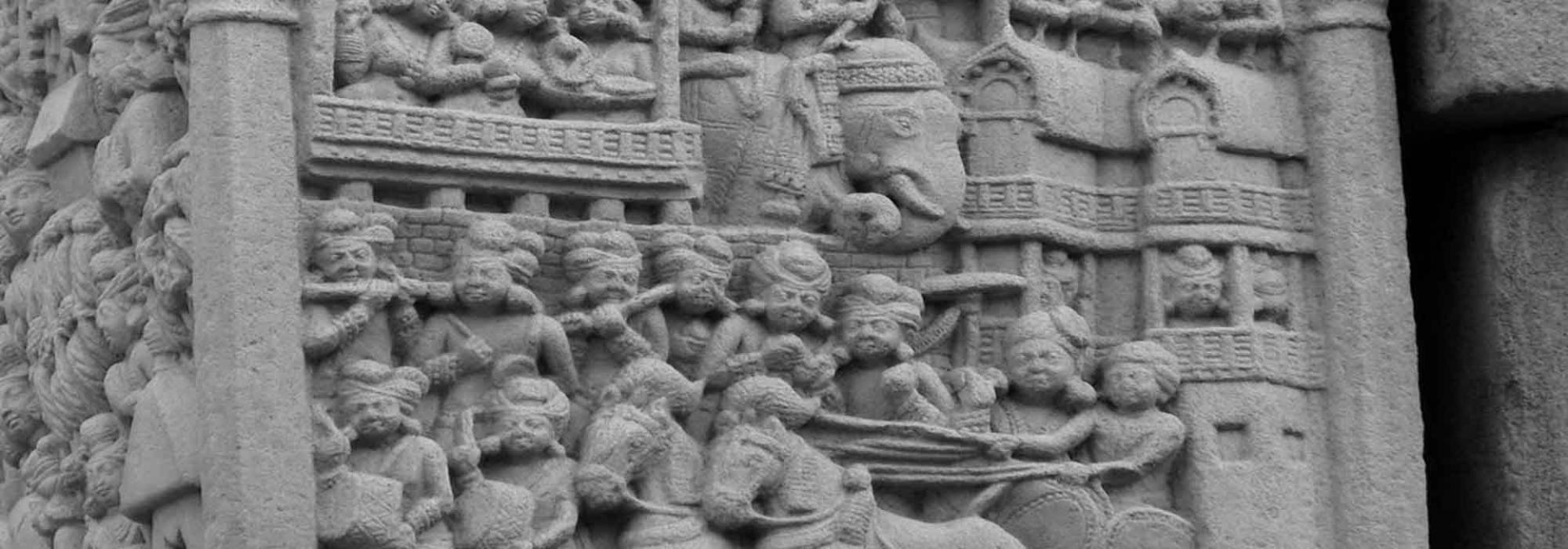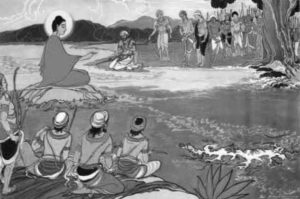Buddha approved of and loved both the system of republics as well as the system of monarchy. He himself came from a republics establishment; he belonged to the Śākya-gaṇa. The republic that lay close to it was the Kolīya-gaṇa. There was a huge quarrel between the Śākya-gaṇa and the Kolīya-gaṇa with regard to sharing the waters of the River Rohiṇī.
Buddha was someone who saw firsthand the fights between the different republics. The people of the Malla-gaṇa were his devotees, as were those of the Licchavi-gaṇa. On the other hand, totally opposed to the system of republics, the emperor of Magadha Ajātaśatru and his father Bimbisāra Śreṇyaka who held the Buddha in great reverence as did King Prasenajit of Kosala and his son, Prince Viḍhūratha. Prasenajit was so respectful towards the Buddha that he insists that he would marry a princess from the Śākya-gaṇa. But the Śākyas were orthodox, narrow-minded, and considered themselves to be of a higher clan; they had the mindset that a maiden from their republic should not be given in marriage outside. But Prasenajit was mighty. He sent a message to the Śākyas. If his desire was not fulfilled their republic itself would be destroyed; it is for this reason they gave their consent and identified a maiden from their land to give in marriage to the king.
Prasenajit was clever. He told his ministers, "Examine and see: the Śākyas have great regard for their own clan and republic. Indeed I have great devotion towards the Buddha. But they are so clannish and conceited, I'm unsure if they will actually give one of their maidens to me in marriage; you should examine this carefully." What the Śākyas had done was to dress up a servant-girl in the costly robes of a Śākya bride; they had no intention of marrying off one of their princesses to Prasenajit.
The mediators who had gone there said, "This girl must eat in the same plate as her father. Only then will we agree to this proposal." Like the famous proverb, if they were ready to get to the bottom of it by going under the carpet, she was willing to go under the rangoli! One of the heads of the Śākyas by name Mahānāma made the servant-girl sit in front of him; whatever was served to his plate, he ate a few morsels; then she began mixing the rice on the plate. Suddenly, an anxious messenger walked in. Mahānāma took the letter with his left hand, read it carefully, and gives the details of what should be done. Even during this time, he was mixing the rice with his right hand. As for her, she ate up everything that was there on the plate.
The ministers of Prasenajit thought that they both had eaten from the same plate. But it was only the girl who had eaten after Mahānāma had touched the food; after the girl began eating, Mahānāma had not eaten a single morsel of food (thus saving himself from pollution). The poor ministers of Prasenajit didn't realize this. Their suspicions about the girl were allayed. They were under the illusion that she was a girl from the Śākya clan.
She got married to Prasenajit too. They had a son named Viḍhūratha. During his teenage years, he once went to his maternal grandfather's place. 'This boy is a son of a slave; how can we give him the honour that is equal to one of us? If our children mix with him, then they will be spiritually defiled!' Thinking thus, the leaders of the Śākyas sent all the young men and women of his age-group from the city to another part of the land. And the infants and elders who remained, how much of entertainment could they possibly provide to him? Within a few days, he got bored and returned to Kosala.
One of his family members returned to the city because he had forgotten something. There he encountered an old woman who told him in a grudging tone, "There was some son of a slave who had come here. I'm an old lady; at this age, I have to clean this place and purify it, for it has become defiled by his presence." Learning this truth, the family member at once complained to Viḍhūratha. He was enraged beyond control. "These people have insulted me. They have cheated my father." He destroyed the entire Śākya clan; we learn this from history. That, in short, is the story of the love, trust, and democracy that was there among the republics!
How much longer should have such republics existed? Apart from internal weakness, the people in each republic were conceited about their clan, their community; just as an example to show the extent of the arrogance we can quote this from the Buddhist works.
Mallikā, the wife of Bandhula of the Malla-gaṇa wanted to go to the Abhiṣeka-sarovara, which was situated in Vaiśālī, the capital city of the Licchavi-gaṇa. She wanted to visit that lake and engage in water-sports; she said that it was the 'wish of a pregnant woman'! Both the Mallas and the Licchavis were republics; both were vrātya-kṣatriyas. Yet Bandhula had to go to Vaiśālī and battle with the Licchavis because his wife desired to play water-sports in the Abhiṣeka-sarovara. The reason for that was the Licchavis considered the lake to be a sacred spot; the waters of the lake would purify them.
Whenever a leader of the Licchavis died, another person from the same family took his place. This was a hereditary system. And when the next member of the family took the spot of the deceased, he was to take a ritual bath in the lake and it would be the only time he would ever bathe in those waters in his lifetime. Thus it was considered a sacred lake. When Mallikā came there to have a bath, five hundred Licchavi warriors resisted them. There is also a story that Bandhula killed them all by shooting arrows at them. With such a closeted mindset that prevailed among the republics, how amicably could one republic engage with another; to what extent was peace possible?
In reality, within every republic there was malicious politics. Let us consider Bandhula's Malla-gana itself; Bandhula was to become the commander-in-chief of the republic. But the people who couldn't stand him, opposed it. He was given the near-impossible task of placing eight axe-handles next to each other (in the mud) and chopping them all into two with just one swift movement of his dagger. They were all wooden stalks. When Bandhulamalla sliced it with great force, only seven handles were chopped; the eighth remained. What they had done was to fill the wooden stalks with iron pieces. When some of his well-wishers said that a courageous hero such as himself should have been able to chop all eight, he said, "When I struck the stalks, I heard a ringing sound and knew at once that they had been filled with metal. I was distressed for a moment at appalling manner in which my own people are cheating me. That brief moment of agony resulted in the eight stalk being untouched." After this episode, Bandhula went to Prasenajit, a sworn enemy of the republics, and became his commander-in-chief. We find all these references in Buddhist texts.
The inherent evil in human nature doesn't change when seen in the context of the republics. Just by entering a republic, a donkey will not become a horse, nor a royal elephant become a goat; such generalizations cannot be drawn. We must have different models suitable to different eras. When people think that all the earlier forms of governance (monarchy and so forth) are old-fashioned and outdated, why don't they hold a similar view when it comes to republics?
Krishna knew this, Chanakya knew this. Krishna knew that the system of republics in the Yādavas was weak and would not last; this is the reason, when the Yādavas of Dvāraka fell, at once he took his great-grandson Vajra to Mathura and crowned him king; he was accepted by all as their sovereign ruler. If Krishna had an inkling that his people, the Yādavas, would ably manage their system of republics, perhaps he might not even have turned towards the Pāṇḍavas.
Good governance is certainly needed; but he was unable to get his people to establish that. These irresponsible people had tasted freedom and the possibility of free thinking. Krishna knew that he could hardly trust them or undertake anything by counting on them; therefore he turned towards the Pāṇḍavas. It was not that the Pāṇḍavas were perfect in all respects; they certainly had numerous shortcomings. Even so, they had an innately strong ethical framework. It was such an establishment aligned to dharma that Samudragupta, Chandragupta Vikramaditya, Kumaragupta, Skandagupta and others brought back. In this matter, there can never be uniformity of opinion. The reason being there is no better alternative to this establishment.
Translated from the original by Sandeep Balakrishna and Hari Ravikumar.
To be continued


















































